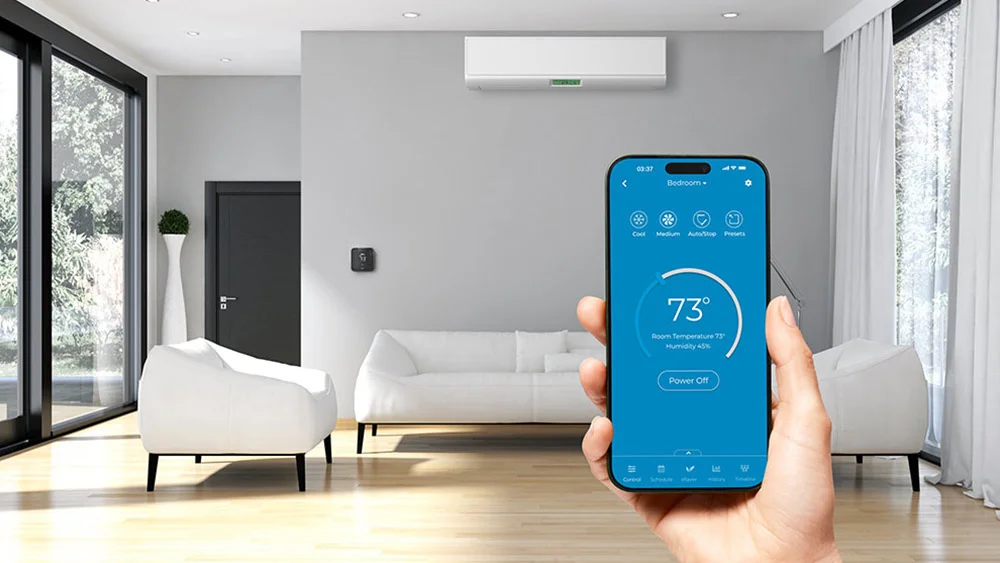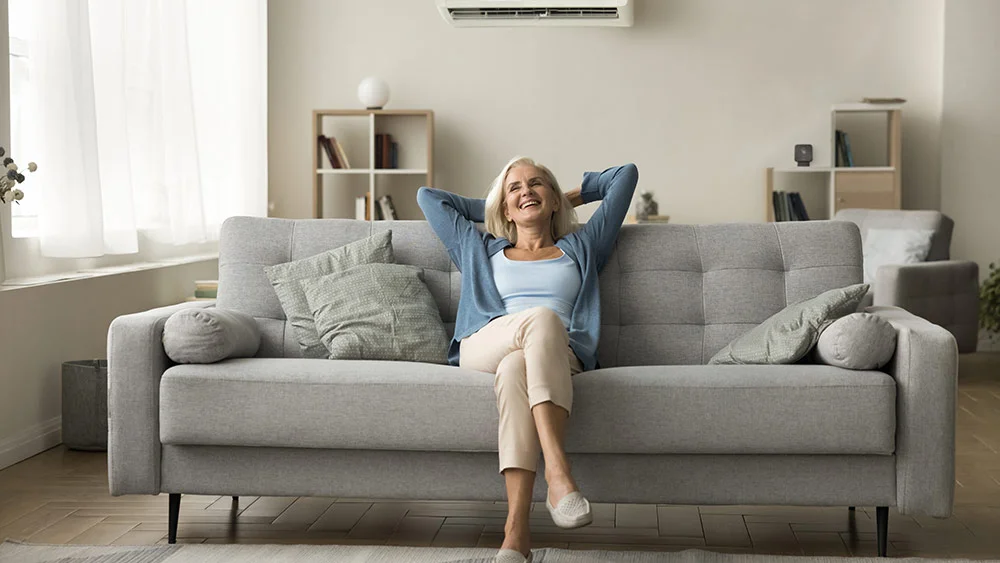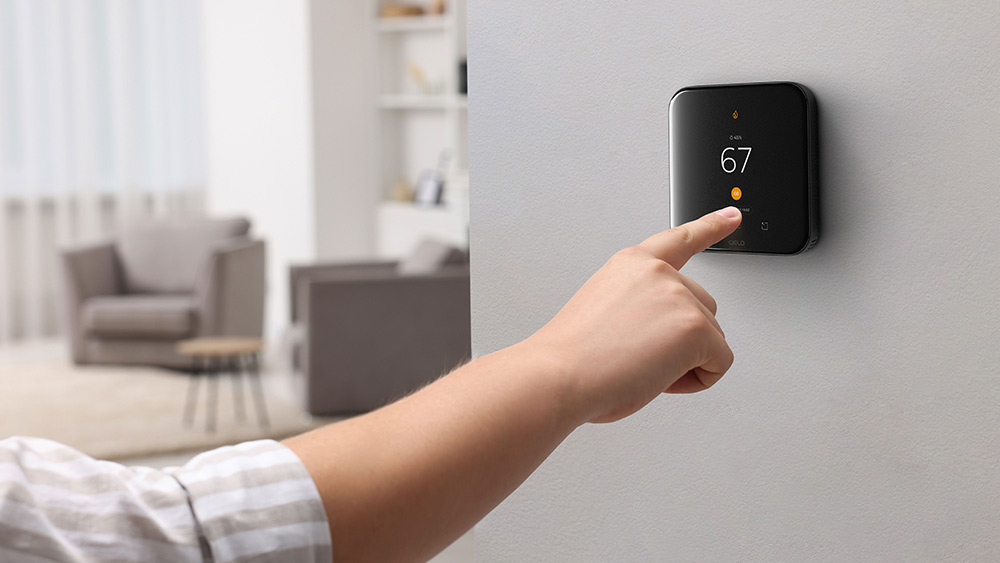
Key Takeaways
- The ideal room temperature is 78°F in summer and 68–70°F in winter for optimal comfort and energy efficiency.
- The ideal sleep temperature is between 65°F for improved sleep quality.
- Use smart thermostats to automate temperature settings and maintain ideal home climate.
Maintaining your room temperature can be tricky. While the thermometer might give you a number, it doesn’t always translate to comfort. Sometimes, your room feels like a sauna; other times, it is like an icebox.
Finding and maintaining the ideal temperature involves more than just monitoring the numbers; it requires a thoughtful approach to address different needs and situations.
This blog has got you covered with the ideal room temperatures for every situation, making it easier than ever to find your comfort zone.
Factors Affecting House Temperature
Determining the indoor temperature experience goes beyond simply checking the external weather conditions. The sensations of warmth or coldness within a home are influenced by a multitude of factors that contribute to the overall comfort level. The most common ones are listed below:
- The degree to which heat is retained or repelled inside a space is directly related to the insulation in your home. A house with enough insulation has a more stable and even interior temperature.
- Thermal comfort is influenced by the living area’s layout and style. The way the windows are arranged, how much light they receive, and how airflow is distributed can all have a big impact on how the inhabitants feel about the temperature. For example, if your home has high ceilings and large windows, you may need to set your air conditioner to a lower temperature or your heating unit to a higher setting compared to someone living in a home with lower ceilings and smaller windows.
- The number of occupants influences a home’s temperature dynamics. As more people produce body heat, the feeling of warmth is impacted.
- A room with higher humidity may seem warmer because it hinders the body’s capacity to cool itself through sweat evaporation. On the other hand, reduced humidity might make it seem colder.
- Appliances and household activities also impact heat production. A home’s overall heat production can be influenced by various activities, including cooking, using electronics, and even lighting design.
- Personal factors such as clothing choices, individual metabolism, and health conditions contribute to the perceived temperature. What feels warm to one person might be chilly to another, emphasizing the subjective nature of thermal comfort.
What Is the Ideal Room Temperature?

Keeping specific differences and geographical variances aside, the average temperature range in a home is generally accepted to be between 70 to 78 F. This can vary greatly due to a host of factors, including the location, seasons, home design, and personal preference.
Ideal Room Temperature in Summer
To stay comfortable while managing energy costs, it’s generally recommended to set your thermostat to 78 F when you are at home. When your home isn’t occupied, it’s a good idea to either increase the temperature or turn off the unit entirely. Using a smart thermostat can simplify this process. You can set a schedule according to your routine or use the geofencing feature to automatically turn on and off your unit based on your location.
Equip your HVAC system with smart features and achieve the perfect balance between comfort & savings.
Learn more
Ideal Room Temperature in Winter
During the winter months, the generally accepted home temperature is preferred to be around 68-70 F when you are awake. Lower your thermostat when you are away or sleeping for energy savings.
Related: What Temperature to Set Your Thermostat in Winter?
Comfortable Room Temperature for Sleeping
The body’s internal temperature naturally decreases while you sleep, so keeping your room cooler can help you fall asleep more easily and stay asleep throughout the night.
The ideal temperature for good sleep is around 65 F. However, this can vary slightly for different people. Generally, experts suggest setting your thermostat between 65 and 68 F for the best sleep quality.
Ideal Home Temperature When Away
To save on heating and cooling costs, lower your thermostat by 7-10 degrees when your home is unoccupied. The Department of Energy estimates that this adjustment can reduce your energy bills by about 10%.
If you’re going on a summer vacation, setting your thermostat to 85 F is recommended. However, check the weather forecast before you leave; if extremely hot temperatures are expected, you might need to adjust it to a lower setting.
In winter, when you’re away, setting your thermostat between 55 and 60 F is generally optimal. If you live in a region with mild winters and freezing pipes aren’t a concern, you might set it as low as 45 F to save more on heating costs.
Related: What Temperature to Keep Your House While on Vacation?
If the temperature drops below freezing in your area, mini-split heat pumps have a special mode known as ‘Freeze Protection’ that can be utilized to keep the home temperature above freezing. This mode keeps the heat pump running at a low-power heat mode, preventing your home from becoming excessively cold. With mini-split thermostats like Cielo Breez Max, you can activate the FP setting using your phone from anywhere, anytime.
Your best choice to make any mini-split, window,
or portable AC smart. Enhance your comfort and savings.

Ideal Room Temperature for the Elderly
The ideal room temperature for the elderly is generally recommended to be warmer than for younger adults. This is because they are susceptible to sickness due to minor temperature variations. A safe temperature is accepted to be between 68 and 74 F for people above the age of 65. The temperature inside your home should not go below 68F as that increases the risk of respiratory disease and even hypothermia if there is prolonged exposure. This is especially the case for people with lung and heart diseases. Similarly, any temperature above 80 F is too hot for the elderly.
Ideal House Temperature for Babies
Because of their small size and ongoing growth, babies are particularly sensitive to temperature changes. Parents often try to keep them warm by bundling them up, but this can actually be more harmful than helpful. It’s important to maintain a stable room temperature for your baby, avoiding extremes of heat and cold. If a baby becomes too hot, it can increase the risk of SIDS (sudden infant death syndrome), which is highest in the first six months of life.
To ensure your baby’s safety and well-being, the ideal room temperature for newborns should be between 68 and 72 F.
Perfect Room Temperature for Pets
As with humans, pets also need a certain temperature range to function at their best. This temperature depends on the type of coat, the amount of fur, the breed, and the lifestyle of the pet.
Even though there isn’t one temperature that fits all formulas, the thermostat should be set between 75 and 78 F for dogs in summer. For larger breeds of dogs, 75 degrees is preferred. In winter, the best settings are between 68 and 72 F.
In summer, cats should be kept at 85-90 F, while in the winter, a temperature of 68 to 70 degrees is ideal for big cats. For smaller cats, even 78-80 F would be perfectly alright, as they prefer warm temperatures.
Why Greater Control Over Your Home Temperature Matters

According to the US Department of Energy, a staggering 43% of a home’s utility bill is dedicated to heating and cooling. Therefore, it is crucial to manage these costs effectively.
Reduction in temperature set points, economical use of air conditioning, and usage monitoring help in the reduction of AC bills. Smart thermostats for central and room air conditioners enable you to constantly monitor your AC temperatures even when you are not home. If you feel the temperature is too low or too high, you can adjust it instantly and reduce energy consumption. Automatic schedules turn the AC on or off according to pre-programmed timetables, resulting in avoiding excessive use of the AC.
Maintaining the right temperature positively impacts your mood and work productivity. A comfortable environment reduces stress and promotes mental well-being, allowing you to stay focused and efficient. In contrast, extreme temperatures can lead to discomfort and decreased performance.
7 Best Ways to Maintain Your Perfect Room Temperature

1. Automation to Maintain an Ideal Home Temperature
- Smart Thermostats for Central HVAC Systems: Upgrade to a smart thermostat for precise control. Set schedules, monitor remotely, and optimize energy usage for consistent comfort.
- Smart Thermostats for Mini-Splits: If you have ductless systems at home, such as mini-split, window, or portable AC, consider getting a mini-split thermostat. This upgrade equips your AC with smart technology, giving you complete control from anywhere. These thermostats offer a range of features accessible through your smartphone, including setting your preferred temperature settings, geo-fencing, and scheduling for the entire week. This means no more constant adjustments to maintain the ideal room temperature.
2. Humidity Control Improves Room Conditions
Humidity is closely linked with temperature. A humid environment causes sweating and lethargicness, which requires constantly adjusting the temperature of your air conditioner. By keeping humidity levels in a comfortable range between 30% and 50%, you can maintain an ideal home climate.
Here is more information on home humidity levels.
3. Use Zoning for Better Temperature Control
HVAC zoning divides your home into various clusters, each with its own temperature set point and operating mode. For example, you can set the upstairs area at a slightly lower temperature while the lower portion can be at a slightly higher temperature. This is to counter the extra heat in the upper portion as hot air rises.
If one part of the home is too hot and you need to lower the temperature in that particular room, you can achieve this with HVAC zoning. Other rooms of the house can avoid extra cooling. Morever, your air conditioning system does not have to constantly work to equalize the temperatures between two rooms or areas.
4. Make the Best Use of Room Windows
Windows can be a source of heat in the room through sunlight. Therefore, in times of direct sunlight, the room will become much warmer than usual. A solution to this is to use window shades or apply UV filters and colored screens on the windows. This reduces the amount of sunlight and its intensity coming inside the room.
During sunny winter days, open your curtains or blinds to let sunlight naturally warm your home. The sun’s rays can help increase indoor temperatures and reduce heating costs.
5. Maintenance and Upkeep of the HVAC System
Old and faulty HVAC units often have trouble keeping a steady temperature, leading to hot and cold spots in your home. This is due to multiple reasons, the most common of which are leaky pipes and refrigerant leaks. The efficiency of such systems is also low, and they expend a great amount of energy to keep the temperature constant.
You should go for AC replacement if the repair costs are greater than purchasing a new unit. Keeping up with regular HVAC maintenance can help your system stay in shape and also maintain your ideal home temperature.
6. Regular Energy Audits
Utility and HVAC companies are now offering home audits from an HVAC perspective. These professionals thoroughly inspect your home and look for potential sources of heat or cold, such as cracked windows, improperly sealed cabinets, broken doors, and broken ducts or walls. These sources serve as spots for air leakage from the room and result in variations in temperature throughout the day.
Read this article to learn if an HVAC energy audit is worth going for.
7. Appliances Placement Within the Room
Home appliances such as refrigerators, freezers, and computers serve as heat sources within a room. They eject heat. But it is not constant. Heat is emitted only during specific times and during heavy usage. In times such as these, an additional heat source within the room can change the room temperature very quickly. You should place your appliances in rooms where an ideal room temperature is not important.
Ideal Temperature Is the Key to a Comfortable Home
Achieving the ideal home temperature is crucial for a comfortable and functional home environment. By fine-tuning your thermostat to meet the needs of every household member—whether it’s pets, infants, or elderly family members—you create a space that supports health, comfort, and well-being. Additionally, balancing your home’s temperature can impact your energy bills significantly. Adjusting the thermostat when you’re away or using smart thermostats can help save on energy costs without sacrificing comfort.









4 Comments. Leave new
This article provides practical tips tailored to different situations, ensuring everyone can create an ideal indoor environment year-round.
Thank you for this insightful guide on ideal room temperatures and maintenance tips! It’s incredibly helpful to know how to create a comfortable environment for every situation, whether it’s relaxing at home or staying productive at work. Your tips are sure to make a noticeable difference in our daily lives!
I’ve been looking for a smart thermostat for my HVAC system, and Cielo Smart Thermostat seems like the perfect fit. It’s great to have more control over my home temperature.
Thank you for showing an interest in Cielo Smart Thermostat. We would love to hear your review and feedback.